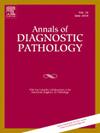Diagnostic value of cyclin D1 immunohistochemistry in differentiating malignant mesothelioma from reactive mesothelial proliferation
IF 1.4
4区 医学
Q3 PATHOLOGY
引用次数: 0
Abstract
Introduction
Although morphologic assessment carries utmost importance in differentiating malignant mesotheliomas (MM) from reactive mesothelial proliferations (RMP), sometimes it may fail to clearly differentiate between these two entities. The aim of this study is to evaluate the potential role of cyclin D1 immunohistochemistry in this differentiation.
Material and methods
Eighty cases (40 MM, 40 RMP) were examined. Nuclear staining of the mesothelial cells was evaluated after cyclin D1 immunostaining. Immunostaining was scored according to the percentage of immunopositive cells (0 %, 1–25 %; 26–50 %; 51–75 %; 76–100 %).
Results
For MMs, 24/40 (60 %) cases demonstrated >50 % staining, with 13/24 in the 51–75 %, 11/24 in the >75 % range. RMPs generally showed no staining (27/40 cases) or 1–25 % staining (11/40 cases) with no cases showing >50 % staining. There was a statistically significant difference between RMP and MM groups according to Cyclin D1 staining percentage (p = 0.001). When 50 % was set as the cut-off value for Cyclin D1 staining, cyclin D1 immunohistochemistry had 60 % sensitivity, 100 % specificity and 80 % accuracy in differential diagnosis between MM and RMP.
Conclusion
In the diagnosis of MM, immunostaining of >50 % of the cells with cyclin D1 is a useful adjunct to morphologic assessment. Although cyclin D1 immunostaining showed high specificity when 50 % immunopositivity was set as a cut-off value in the differentiation between MM and RMP, its sensitivity and accuracy were relatively low. Validation of diagnostic utility of cyclin D1 immunohistochemistry based on the results of relevant prospective studies is necessary before its clinical application.
细胞周期蛋白D1免疫组化在鉴别恶性间皮瘤与反应性间皮瘤增殖中的诊断价值
虽然形态学评估在区分恶性间皮瘤(MM)和反应性间皮瘤(RMP)中至关重要,但有时它可能无法明确区分这两种实体。本研究的目的是评估细胞周期蛋白D1免疫组化在这种分化中的潜在作用。材料与方法检查80例(40 MM, 40 RMP)。细胞周期蛋白D1免疫染色后评价间皮细胞核染色。免疫染色按免疫阳性细胞百分比(0 %,1 - 25%;26-50 %;51 - 75 %;76 - 100年%)。结果mm有24/40例(60%)染色为>; 50%,其中13/24例为51 - 75%,11/24例为>; 75%。RMPs通常无染色(27/40例)或1 - 25%染色(11/40例),没有病例显示50%染色。RMP组与MM组Cyclin D1染色百分比比较,差异有统计学意义(p = 0.001)。当Cyclin D1染色的临界值为50%时,Cyclin D1免疫组化对MM和RMP的鉴别诊断灵敏度为60%,特异性为100%,准确性为80%。结论对50%的细胞进行细胞周期蛋白D1免疫染色是诊断MM的有效辅助手段。虽然以50%的免疫阳性作为区分MM和RMP的临界值时,cyclin D1免疫染色具有较高的特异性,但其敏感性和准确性相对较低。在临床应用之前,有必要基于相关前瞻性研究的结果验证cyclin D1免疫组化的诊断效用。
本文章由计算机程序翻译,如有差异,请以英文原文为准。
求助全文
约1分钟内获得全文
求助全文
来源期刊
CiteScore
3.90
自引率
5.00%
发文量
149
审稿时长
26 days
期刊介绍:
A peer-reviewed journal devoted to the publication of articles dealing with traditional morphologic studies using standard diagnostic techniques and stressing clinicopathological correlations and scientific observation of relevance to the daily practice of pathology. Special features include pathologic-radiologic correlations and pathologic-cytologic correlations.

 求助内容:
求助内容: 应助结果提醒方式:
应助结果提醒方式:


